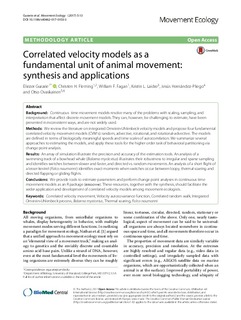| dc.contributor.author | Gurarie, Eliezer | |
| dc.contributor.author | Fleming, Christen H | |
| dc.contributor.author | Fagan, William F | |
| dc.contributor.author | Laidre, Kristin L. | |
| dc.contributor.author | Hernandez-Pliego, Jesus | |
| dc.contributor.author | Ovaskainen, Otso | |
| dc.date.accessioned | 2018-06-28T09:21:58Z | |
| dc.date.available | 2018-06-28T09:21:58Z | |
| dc.date.created | 2017-11-02T15:55:06Z | |
| dc.date.issued | 2017 | |
| dc.identifier.citation | Movement Ecology. 2017, 5 (13). | nb_NO |
| dc.identifier.issn | 2051-3933 | |
| dc.identifier.uri | http://hdl.handle.net/11250/2503532 | |
| dc.description.abstract | Background: Continuous time movement models resolve many of the problems with scaling, sampling, and interpretation that affect discrete movement models. They can, however, be challenging to estimate, have been presented in inconsistent ways, and are not widely used. Methods: We review the literature on integrated Ornstein-Uhlenbeck velocity models and propose four fundamental correlated velocity movement models (CVM’s): random, advective, rotational, and rotational-advective. The models are defined in terms of biologically meaningful speeds and time scales of autocorrelation. We summarize several approaches to estimating the models, and apply these tools for the higher order task of behavioral partitioning via change point analysis. Results: An array of simulation illustrate the precision and accuracy of the estimation tools. An analysis of a swimming track of a bowhead whale (Balaena mysticetus) illustrates their robustness to irregular and sparse sampling and identifies switches between slower and faster, and directed vs. random movements. An analysis of a short flight of a lesser kestrel (Falco naumanni) identifies exact moments when switches occur between loopy, thermal soaring and directed flapping or gliding flights. Conclusions: We provide tools to estimate parameters and perform change point analyses in continuous time movement models as an R package (smoove). These resources, together with the synthesis, should facilitate the wider application and development of correlated velocity models among movement ecologists | nb_NO |
| dc.language.iso | eng | nb_NO |
| dc.publisher | Springer Nature/ BioMed Central | |
| dc.rights | Navngivelse 4.0 Internasjonal | * |
| dc.rights.uri | http://creativecommons.org/licenses/by/4.0/deed.no | * |
| dc.title | Correlated velocity models as a fundamental unit of animal movement: Synthesis and applications | nb_NO |
| dc.type | Journal article | nb_NO |
| dc.type | Peer reviewed | nb_NO |
| dc.description.version | publishedVersion | nb_NO |
| dc.source.pagenumber | 18 | nb_NO |
| dc.source.volume | 5 | nb_NO |
| dc.source.journal | Movement Ecology | nb_NO |
| dc.source.issue | 13 | nb_NO |
| dc.identifier.doi | 10.1186/s40462-017-0103-3 | |
| dc.identifier.cristin | 1510450 | |
| dc.description.localcode | © The Author(s). 2017 Open Access This article is distributed under the terms of the Creative Commons Attribution 4.0 International License (http://creativecommons.org/licenses/by/4.0/), which permits unrestricted use, distribution, and reproduction in any medium, provided you give appropriate credit to the original author(s) and the source, provide a link to the Creative Commons license, and indicate if changes were made. The Creative Commons Public Domain Dedication waiver (http://creativecommons.org/publicdomain/zero/1.0/) applies to the data made available in this article, unless otherwise stated. | nb_NO |
| cristin.unitcode | 194,66,10,0 | |
| cristin.unitname | Institutt for biologi | |
| cristin.ispublished | true | |
| cristin.fulltext | original | |
| cristin.qualitycode | 1 | |

